Accounting Theory and Current Issues Report for AGL Energy Limited
VerifiedAdded on 2022/11/18
|11
|2935
|153
Report
AI Summary
This report examines accounting theory and current issues, using AGL Energy Limited as a case study. It delves into various accounting theories like materiality, cost principle, and conservatism, highlighting their application in AGL Energy's financial statements. The report discusses the conceptual framework of the Australian Accounting Standards Board (AASB) and its impact on financial reporting, comparing it with GAAP. Key elements of financial statements, including revenue, expenses, assets, liabilities, and equity, are analyzed. The valuation methods used by AGL Energy, particularly fair value and historical cost, are evaluated. The report identifies and analyzes specific items from AGL Energy's annual report, such as plant and equipment, intangible assets, receivables, and cash equivalents, as well as liabilities including borrowings, provisions, and payables. The treatment of investments in associates and joint ventures is also considered. Finally, the report assesses the advantages and disadvantages of utilizing the Australian framework in accounting practices.
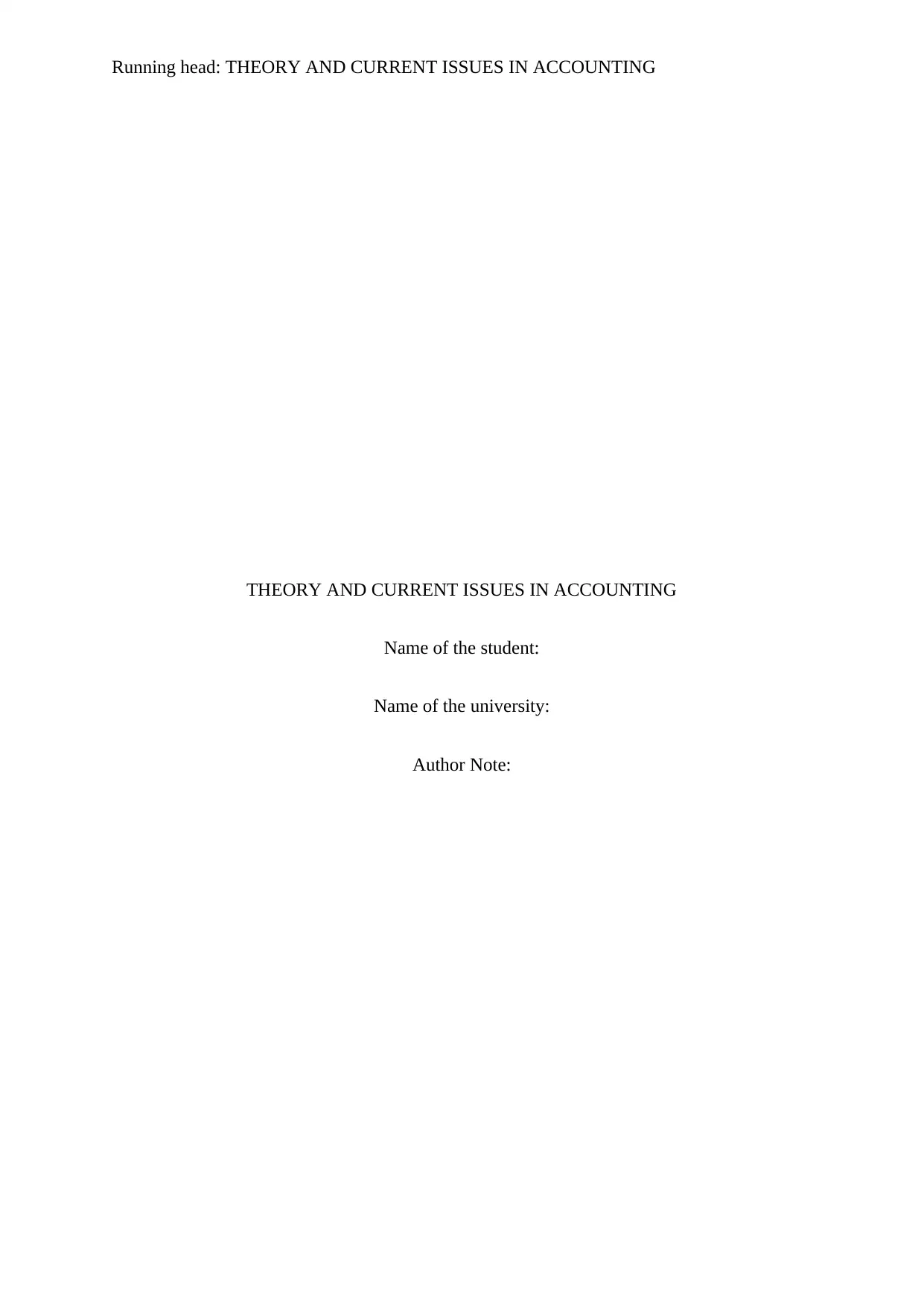
Running head: THEORY AND CURRENT ISSUES IN ACCOUNTING
THEORY AND CURRENT ISSUES IN ACCOUNTING
Name of the student:
Name of the university:
Author Note:
THEORY AND CURRENT ISSUES IN ACCOUNTING
Name of the student:
Name of the university:
Author Note:
Paraphrase This Document
Need a fresh take? Get an instant paraphrase of this document with our AI Paraphraser
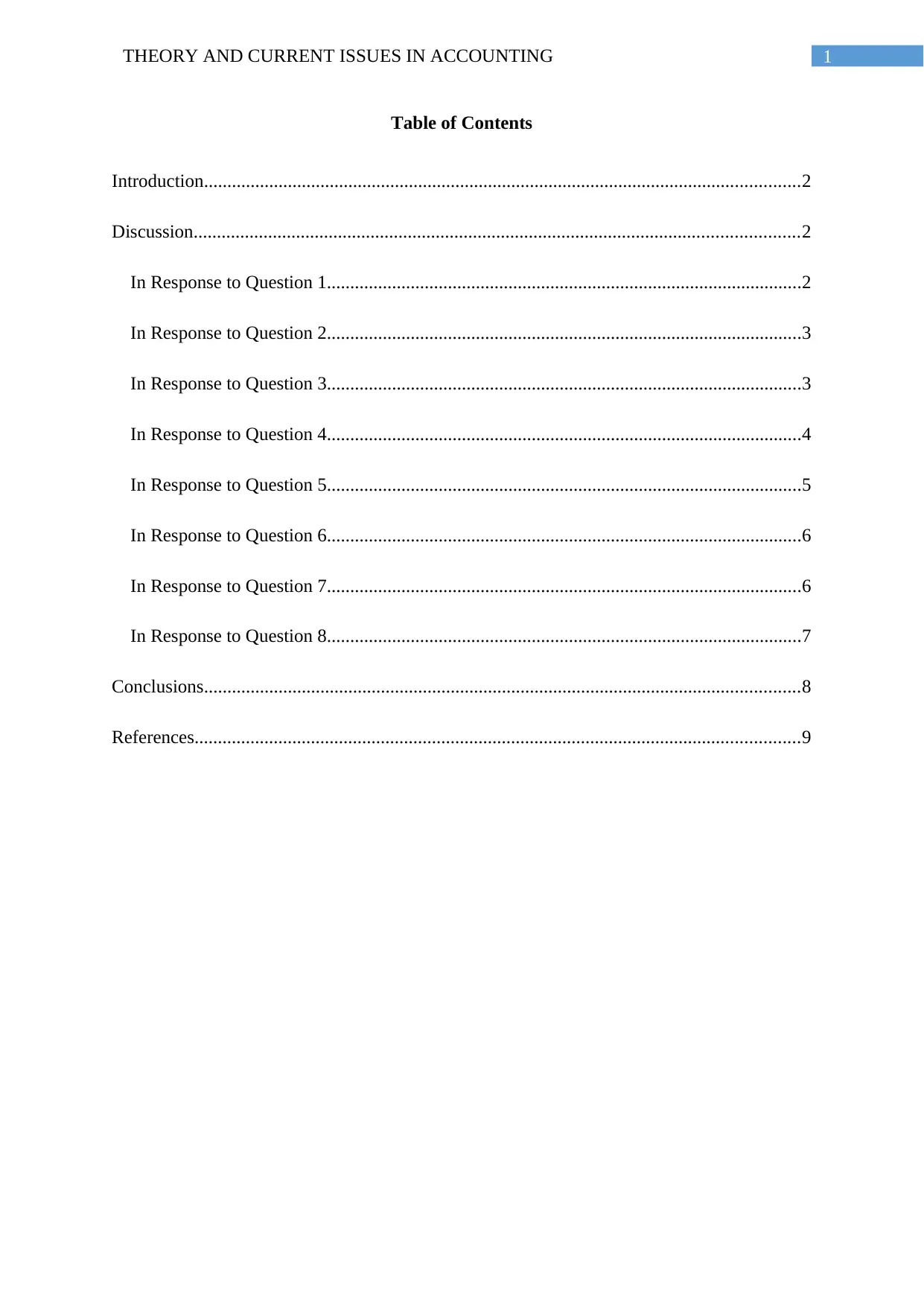
1THEORY AND CURRENT ISSUES IN ACCOUNTING
Table of Contents
Introduction................................................................................................................................2
Discussion..................................................................................................................................2
In Response to Question 1......................................................................................................2
In Response to Question 2......................................................................................................3
In Response to Question 3......................................................................................................3
In Response to Question 4......................................................................................................4
In Response to Question 5......................................................................................................5
In Response to Question 6......................................................................................................6
In Response to Question 7......................................................................................................6
In Response to Question 8......................................................................................................7
Conclusions................................................................................................................................8
References..................................................................................................................................9
Table of Contents
Introduction................................................................................................................................2
Discussion..................................................................................................................................2
In Response to Question 1......................................................................................................2
In Response to Question 2......................................................................................................3
In Response to Question 3......................................................................................................3
In Response to Question 4......................................................................................................4
In Response to Question 5......................................................................................................5
In Response to Question 6......................................................................................................6
In Response to Question 7......................................................................................................6
In Response to Question 8......................................................................................................7
Conclusions................................................................................................................................8
References..................................................................................................................................9
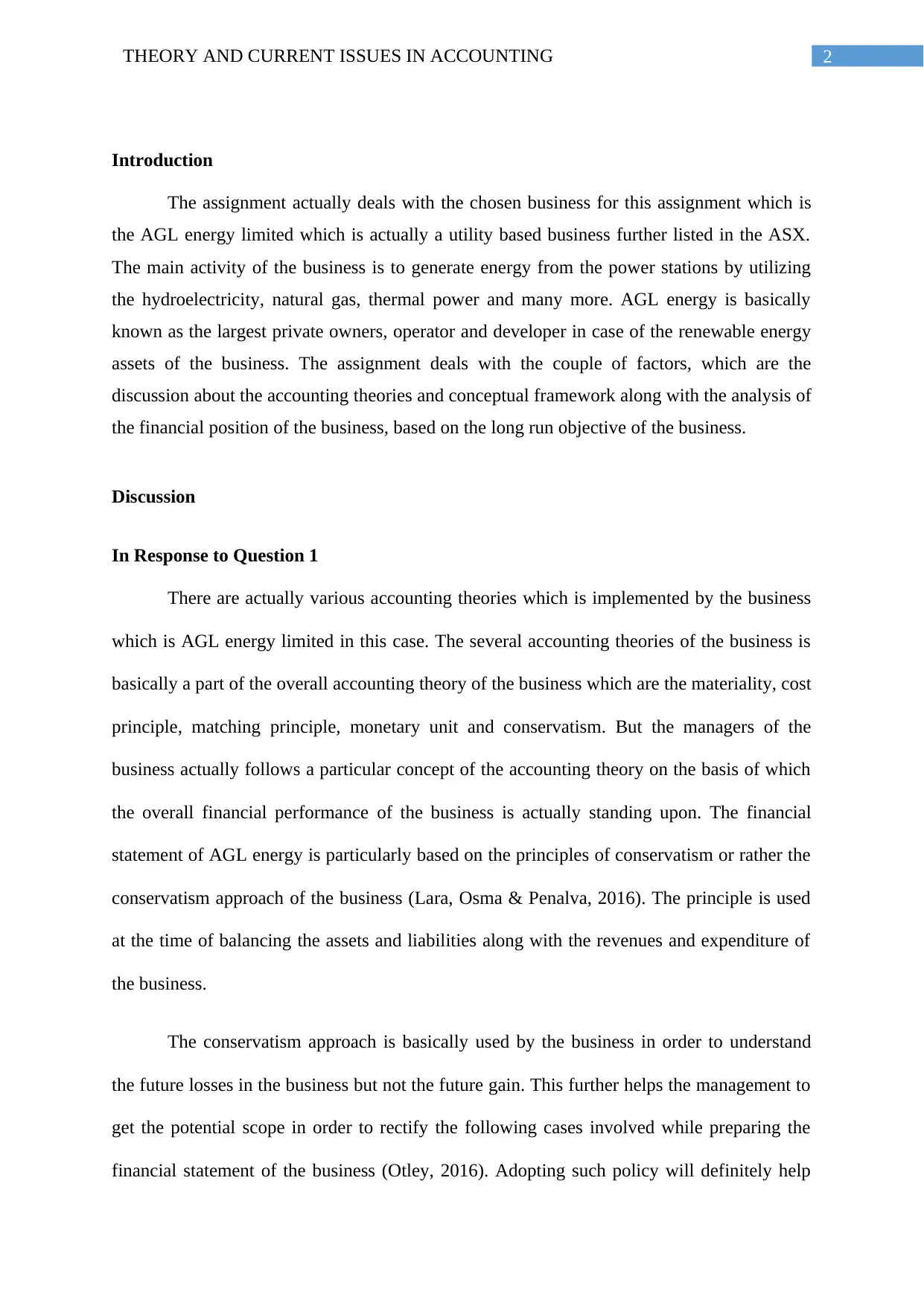
2THEORY AND CURRENT ISSUES IN ACCOUNTING
Introduction
The assignment actually deals with the chosen business for this assignment which is
the AGL energy limited which is actually a utility based business further listed in the ASX.
The main activity of the business is to generate energy from the power stations by utilizing
the hydroelectricity, natural gas, thermal power and many more. AGL energy is basically
known as the largest private owners, operator and developer in case of the renewable energy
assets of the business. The assignment deals with the couple of factors, which are the
discussion about the accounting theories and conceptual framework along with the analysis of
the financial position of the business, based on the long run objective of the business.
Discussion
In Response to Question 1
There are actually various accounting theories which is implemented by the business
which is AGL energy limited in this case. The several accounting theories of the business is
basically a part of the overall accounting theory of the business which are the materiality, cost
principle, matching principle, monetary unit and conservatism. But the managers of the
business actually follows a particular concept of the accounting theory on the basis of which
the overall financial performance of the business is actually standing upon. The financial
statement of AGL energy is particularly based on the principles of conservatism or rather the
conservatism approach of the business (Lara, Osma & Penalva, 2016). The principle is used
at the time of balancing the assets and liabilities along with the revenues and expenditure of
the business.
The conservatism approach is basically used by the business in order to understand
the future losses in the business but not the future gain. This further helps the management to
get the potential scope in order to rectify the following cases involved while preparing the
financial statement of the business (Otley, 2016). Adopting such policy will definitely help
Introduction
The assignment actually deals with the chosen business for this assignment which is
the AGL energy limited which is actually a utility based business further listed in the ASX.
The main activity of the business is to generate energy from the power stations by utilizing
the hydroelectricity, natural gas, thermal power and many more. AGL energy is basically
known as the largest private owners, operator and developer in case of the renewable energy
assets of the business. The assignment deals with the couple of factors, which are the
discussion about the accounting theories and conceptual framework along with the analysis of
the financial position of the business, based on the long run objective of the business.
Discussion
In Response to Question 1
There are actually various accounting theories which is implemented by the business
which is AGL energy limited in this case. The several accounting theories of the business is
basically a part of the overall accounting theory of the business which are the materiality, cost
principle, matching principle, monetary unit and conservatism. But the managers of the
business actually follows a particular concept of the accounting theory on the basis of which
the overall financial performance of the business is actually standing upon. The financial
statement of AGL energy is particularly based on the principles of conservatism or rather the
conservatism approach of the business (Lara, Osma & Penalva, 2016). The principle is used
at the time of balancing the assets and liabilities along with the revenues and expenditure of
the business.
The conservatism approach is basically used by the business in order to understand
the future losses in the business but not the future gain. This further helps the management to
get the potential scope in order to rectify the following cases involved while preparing the
financial statement of the business (Otley, 2016). Adopting such policy will definitely help
⊘ This is a preview!⊘
Do you want full access?
Subscribe today to unlock all pages.

Trusted by 1+ million students worldwide
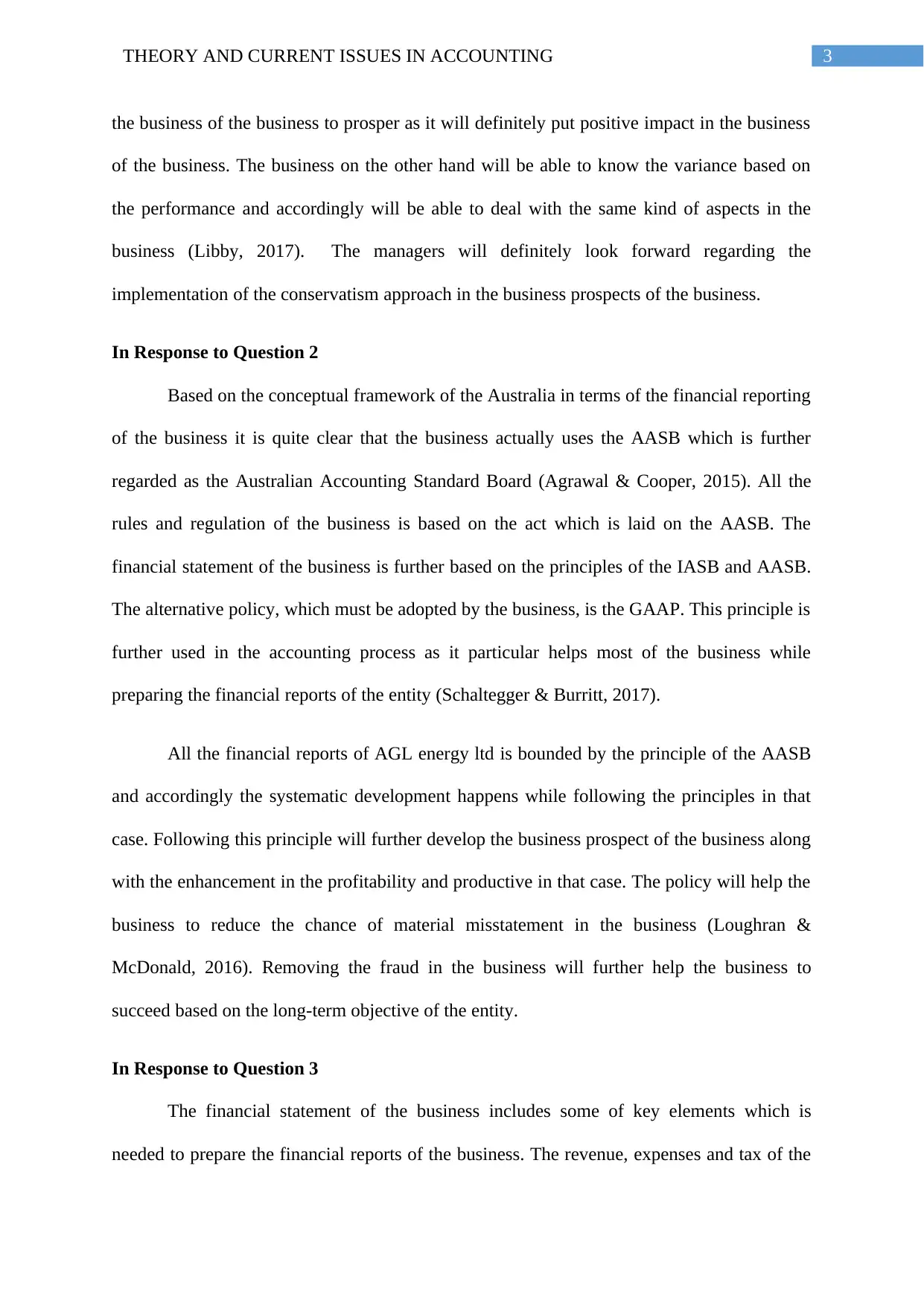
3THEORY AND CURRENT ISSUES IN ACCOUNTING
the business of the business to prosper as it will definitely put positive impact in the business
of the business. The business on the other hand will be able to know the variance based on
the performance and accordingly will be able to deal with the same kind of aspects in the
business (Libby, 2017). The managers will definitely look forward regarding the
implementation of the conservatism approach in the business prospects of the business.
In Response to Question 2
Based on the conceptual framework of the Australia in terms of the financial reporting
of the business it is quite clear that the business actually uses the AASB which is further
regarded as the Australian Accounting Standard Board (Agrawal & Cooper, 2015). All the
rules and regulation of the business is based on the act which is laid on the AASB. The
financial statement of the business is further based on the principles of the IASB and AASB.
The alternative policy, which must be adopted by the business, is the GAAP. This principle is
further used in the accounting process as it particular helps most of the business while
preparing the financial reports of the entity (Schaltegger & Burritt, 2017).
All the financial reports of AGL energy ltd is bounded by the principle of the AASB
and accordingly the systematic development happens while following the principles in that
case. Following this principle will further develop the business prospect of the business along
with the enhancement in the profitability and productive in that case. The policy will help the
business to reduce the chance of material misstatement in the business (Loughran &
McDonald, 2016). Removing the fraud in the business will further help the business to
succeed based on the long-term objective of the entity.
In Response to Question 3
The financial statement of the business includes some of key elements which is
needed to prepare the financial reports of the business. The revenue, expenses and tax of the
the business of the business to prosper as it will definitely put positive impact in the business
of the business. The business on the other hand will be able to know the variance based on
the performance and accordingly will be able to deal with the same kind of aspects in the
business (Libby, 2017). The managers will definitely look forward regarding the
implementation of the conservatism approach in the business prospects of the business.
In Response to Question 2
Based on the conceptual framework of the Australia in terms of the financial reporting
of the business it is quite clear that the business actually uses the AASB which is further
regarded as the Australian Accounting Standard Board (Agrawal & Cooper, 2015). All the
rules and regulation of the business is based on the act which is laid on the AASB. The
financial statement of the business is further based on the principles of the IASB and AASB.
The alternative policy, which must be adopted by the business, is the GAAP. This principle is
further used in the accounting process as it particular helps most of the business while
preparing the financial reports of the entity (Schaltegger & Burritt, 2017).
All the financial reports of AGL energy ltd is bounded by the principle of the AASB
and accordingly the systematic development happens while following the principles in that
case. Following this principle will further develop the business prospect of the business along
with the enhancement in the profitability and productive in that case. The policy will help the
business to reduce the chance of material misstatement in the business (Loughran &
McDonald, 2016). Removing the fraud in the business will further help the business to
succeed based on the long-term objective of the entity.
In Response to Question 3
The financial statement of the business includes some of key elements which is
needed to prepare the financial reports of the business. The revenue, expenses and tax of the
Paraphrase This Document
Need a fresh take? Get an instant paraphrase of this document with our AI Paraphraser
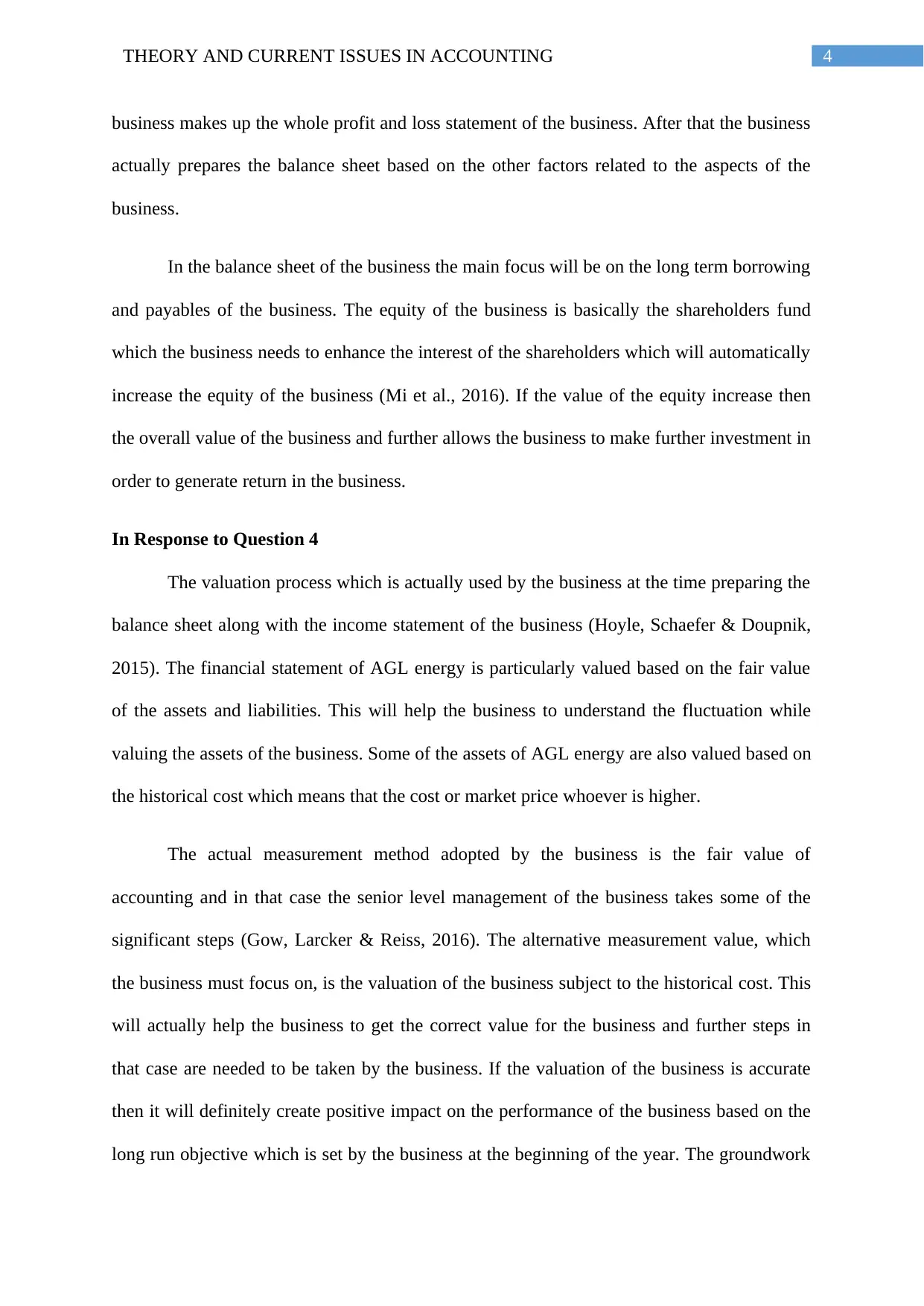
4THEORY AND CURRENT ISSUES IN ACCOUNTING
business makes up the whole profit and loss statement of the business. After that the business
actually prepares the balance sheet based on the other factors related to the aspects of the
business.
In the balance sheet of the business the main focus will be on the long term borrowing
and payables of the business. The equity of the business is basically the shareholders fund
which the business needs to enhance the interest of the shareholders which will automatically
increase the equity of the business (Mi et al., 2016). If the value of the equity increase then
the overall value of the business and further allows the business to make further investment in
order to generate return in the business.
In Response to Question 4
The valuation process which is actually used by the business at the time preparing the
balance sheet along with the income statement of the business (Hoyle, Schaefer & Doupnik,
2015). The financial statement of AGL energy is particularly valued based on the fair value
of the assets and liabilities. This will help the business to understand the fluctuation while
valuing the assets of the business. Some of the assets of AGL energy are also valued based on
the historical cost which means that the cost or market price whoever is higher.
The actual measurement method adopted by the business is the fair value of
accounting and in that case the senior level management of the business takes some of the
significant steps (Gow, Larcker & Reiss, 2016). The alternative measurement value, which
the business must focus on, is the valuation of the business subject to the historical cost. This
will actually help the business to get the correct value for the business and further steps in
that case are needed to be taken by the business. If the valuation of the business is accurate
then it will definitely create positive impact on the performance of the business based on the
long run objective which is set by the business at the beginning of the year. The groundwork
business makes up the whole profit and loss statement of the business. After that the business
actually prepares the balance sheet based on the other factors related to the aspects of the
business.
In the balance sheet of the business the main focus will be on the long term borrowing
and payables of the business. The equity of the business is basically the shareholders fund
which the business needs to enhance the interest of the shareholders which will automatically
increase the equity of the business (Mi et al., 2016). If the value of the equity increase then
the overall value of the business and further allows the business to make further investment in
order to generate return in the business.
In Response to Question 4
The valuation process which is actually used by the business at the time preparing the
balance sheet along with the income statement of the business (Hoyle, Schaefer & Doupnik,
2015). The financial statement of AGL energy is particularly valued based on the fair value
of the assets and liabilities. This will help the business to understand the fluctuation while
valuing the assets of the business. Some of the assets of AGL energy are also valued based on
the historical cost which means that the cost or market price whoever is higher.
The actual measurement method adopted by the business is the fair value of
accounting and in that case the senior level management of the business takes some of the
significant steps (Gow, Larcker & Reiss, 2016). The alternative measurement value, which
the business must focus on, is the valuation of the business subject to the historical cost. This
will actually help the business to get the correct value for the business and further steps in
that case are needed to be taken by the business. If the valuation of the business is accurate
then it will definitely create positive impact on the performance of the business based on the
long run objective which is set by the business at the beginning of the year. The groundwork
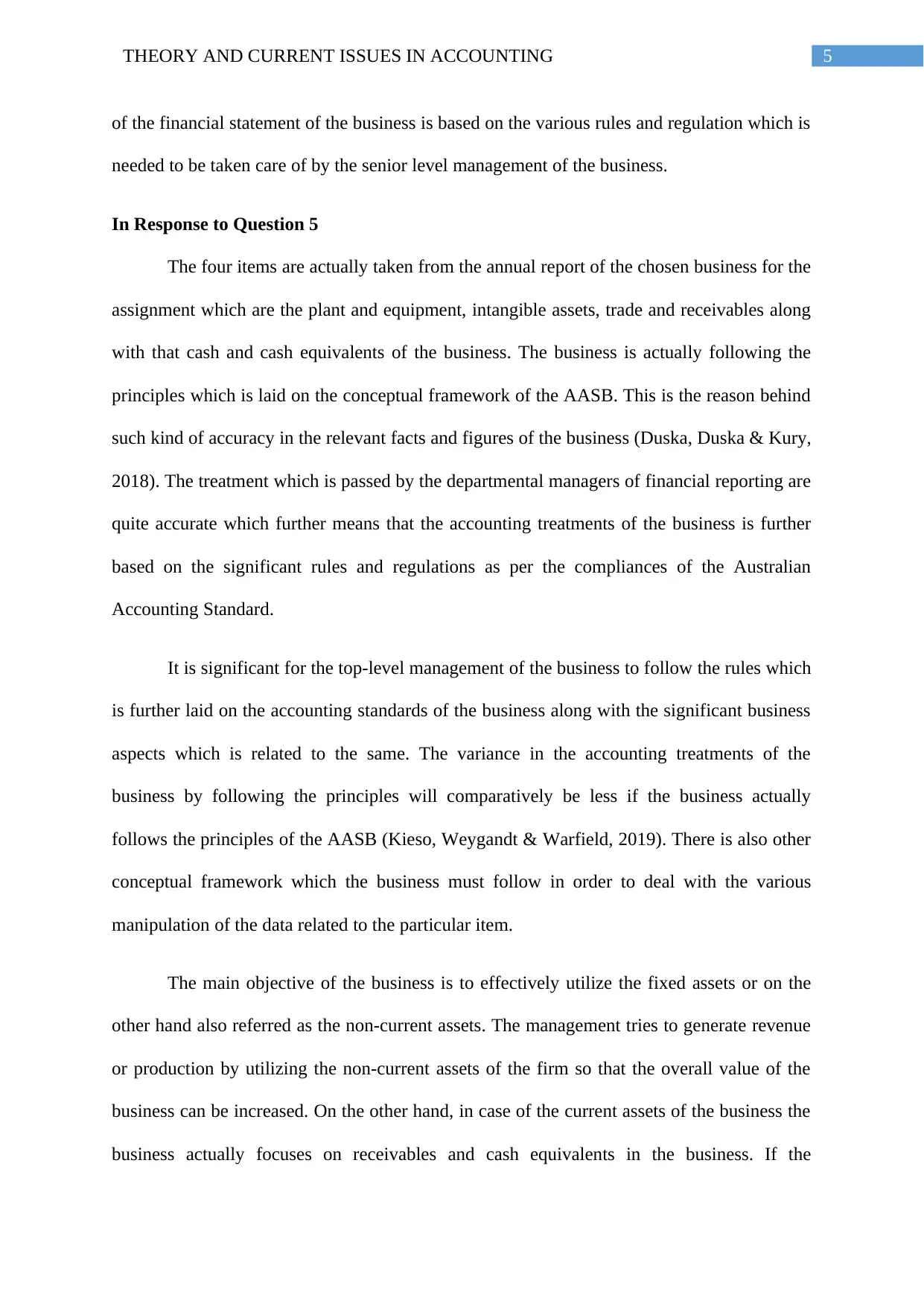
5THEORY AND CURRENT ISSUES IN ACCOUNTING
of the financial statement of the business is based on the various rules and regulation which is
needed to be taken care of by the senior level management of the business.
In Response to Question 5
The four items are actually taken from the annual report of the chosen business for the
assignment which are the plant and equipment, intangible assets, trade and receivables along
with that cash and cash equivalents of the business. The business is actually following the
principles which is laid on the conceptual framework of the AASB. This is the reason behind
such kind of accuracy in the relevant facts and figures of the business (Duska, Duska & Kury,
2018). The treatment which is passed by the departmental managers of financial reporting are
quite accurate which further means that the accounting treatments of the business is further
based on the significant rules and regulations as per the compliances of the Australian
Accounting Standard.
It is significant for the top-level management of the business to follow the rules which
is further laid on the accounting standards of the business along with the significant business
aspects which is related to the same. The variance in the accounting treatments of the
business by following the principles will comparatively be less if the business actually
follows the principles of the AASB (Kieso, Weygandt & Warfield, 2019). There is also other
conceptual framework which the business must follow in order to deal with the various
manipulation of the data related to the particular item.
The main objective of the business is to effectively utilize the fixed assets or on the
other hand also referred as the non-current assets. The management tries to generate revenue
or production by utilizing the non-current assets of the firm so that the overall value of the
business can be increased. On the other hand, in case of the current assets of the business the
business actually focuses on receivables and cash equivalents in the business. If the
of the financial statement of the business is based on the various rules and regulation which is
needed to be taken care of by the senior level management of the business.
In Response to Question 5
The four items are actually taken from the annual report of the chosen business for the
assignment which are the plant and equipment, intangible assets, trade and receivables along
with that cash and cash equivalents of the business. The business is actually following the
principles which is laid on the conceptual framework of the AASB. This is the reason behind
such kind of accuracy in the relevant facts and figures of the business (Duska, Duska & Kury,
2018). The treatment which is passed by the departmental managers of financial reporting are
quite accurate which further means that the accounting treatments of the business is further
based on the significant rules and regulations as per the compliances of the Australian
Accounting Standard.
It is significant for the top-level management of the business to follow the rules which
is further laid on the accounting standards of the business along with the significant business
aspects which is related to the same. The variance in the accounting treatments of the
business by following the principles will comparatively be less if the business actually
follows the principles of the AASB (Kieso, Weygandt & Warfield, 2019). There is also other
conceptual framework which the business must follow in order to deal with the various
manipulation of the data related to the particular item.
The main objective of the business is to effectively utilize the fixed assets or on the
other hand also referred as the non-current assets. The management tries to generate revenue
or production by utilizing the non-current assets of the firm so that the overall value of the
business can be increased. On the other hand, in case of the current assets of the business the
business actually focuses on receivables and cash equivalents in the business. If the
⊘ This is a preview!⊘
Do you want full access?
Subscribe today to unlock all pages.

Trusted by 1+ million students worldwide
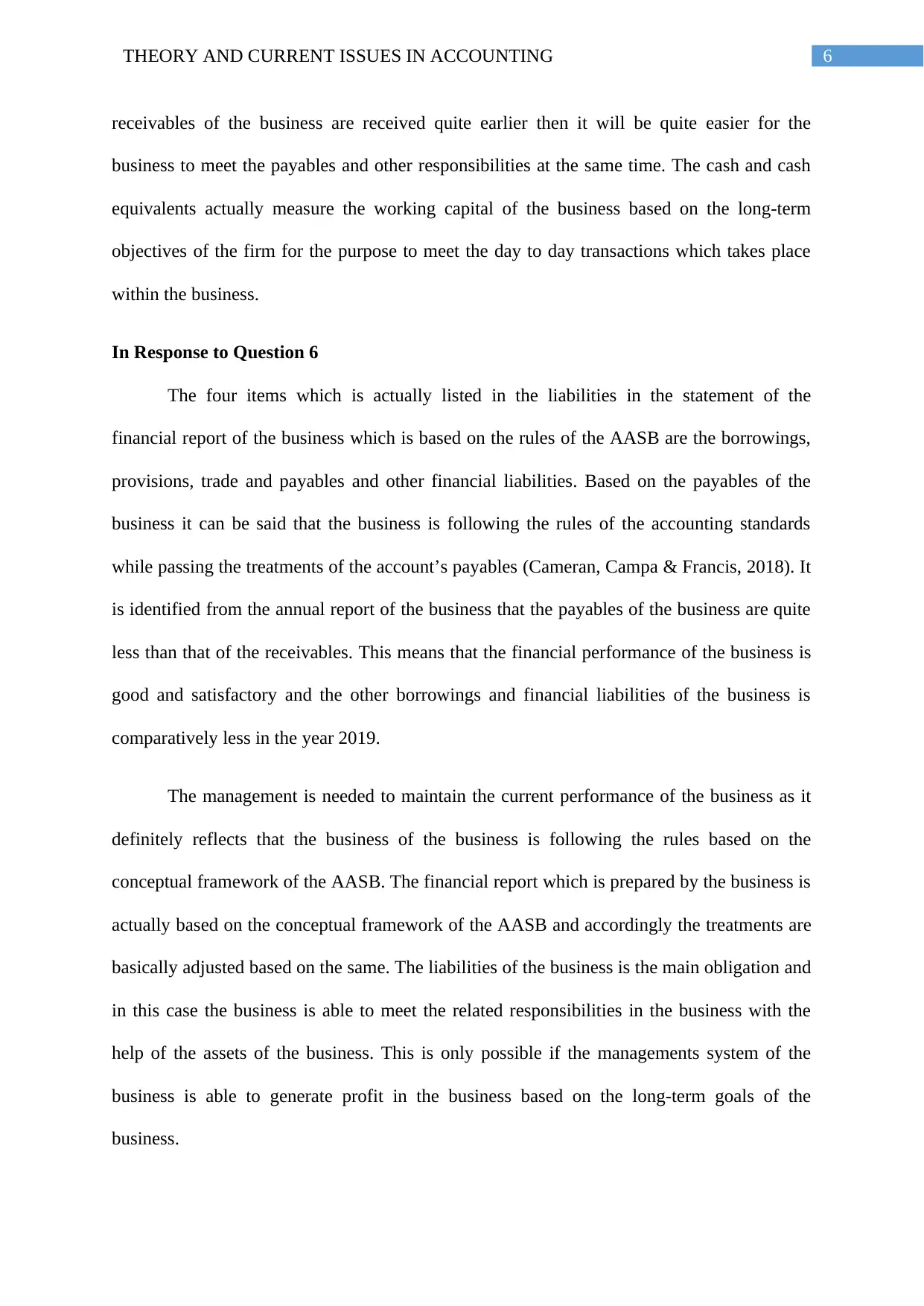
6THEORY AND CURRENT ISSUES IN ACCOUNTING
receivables of the business are received quite earlier then it will be quite easier for the
business to meet the payables and other responsibilities at the same time. The cash and cash
equivalents actually measure the working capital of the business based on the long-term
objectives of the firm for the purpose to meet the day to day transactions which takes place
within the business.
In Response to Question 6
The four items which is actually listed in the liabilities in the statement of the
financial report of the business which is based on the rules of the AASB are the borrowings,
provisions, trade and payables and other financial liabilities. Based on the payables of the
business it can be said that the business is following the rules of the accounting standards
while passing the treatments of the account’s payables (Cameran, Campa & Francis, 2018). It
is identified from the annual report of the business that the payables of the business are quite
less than that of the receivables. This means that the financial performance of the business is
good and satisfactory and the other borrowings and financial liabilities of the business is
comparatively less in the year 2019.
The management is needed to maintain the current performance of the business as it
definitely reflects that the business of the business is following the rules based on the
conceptual framework of the AASB. The financial report which is prepared by the business is
actually based on the conceptual framework of the AASB and accordingly the treatments are
basically adjusted based on the same. The liabilities of the business is the main obligation and
in this case the business is able to meet the related responsibilities in the business with the
help of the assets of the business. This is only possible if the managements system of the
business is able to generate profit in the business based on the long-term goals of the
business.
receivables of the business are received quite earlier then it will be quite easier for the
business to meet the payables and other responsibilities at the same time. The cash and cash
equivalents actually measure the working capital of the business based on the long-term
objectives of the firm for the purpose to meet the day to day transactions which takes place
within the business.
In Response to Question 6
The four items which is actually listed in the liabilities in the statement of the
financial report of the business which is based on the rules of the AASB are the borrowings,
provisions, trade and payables and other financial liabilities. Based on the payables of the
business it can be said that the business is following the rules of the accounting standards
while passing the treatments of the account’s payables (Cameran, Campa & Francis, 2018). It
is identified from the annual report of the business that the payables of the business are quite
less than that of the receivables. This means that the financial performance of the business is
good and satisfactory and the other borrowings and financial liabilities of the business is
comparatively less in the year 2019.
The management is needed to maintain the current performance of the business as it
definitely reflects that the business of the business is following the rules based on the
conceptual framework of the AASB. The financial report which is prepared by the business is
actually based on the conceptual framework of the AASB and accordingly the treatments are
basically adjusted based on the same. The liabilities of the business is the main obligation and
in this case the business is able to meet the related responsibilities in the business with the
help of the assets of the business. This is only possible if the managements system of the
business is able to generate profit in the business based on the long-term goals of the
business.
Paraphrase This Document
Need a fresh take? Get an instant paraphrase of this document with our AI Paraphraser
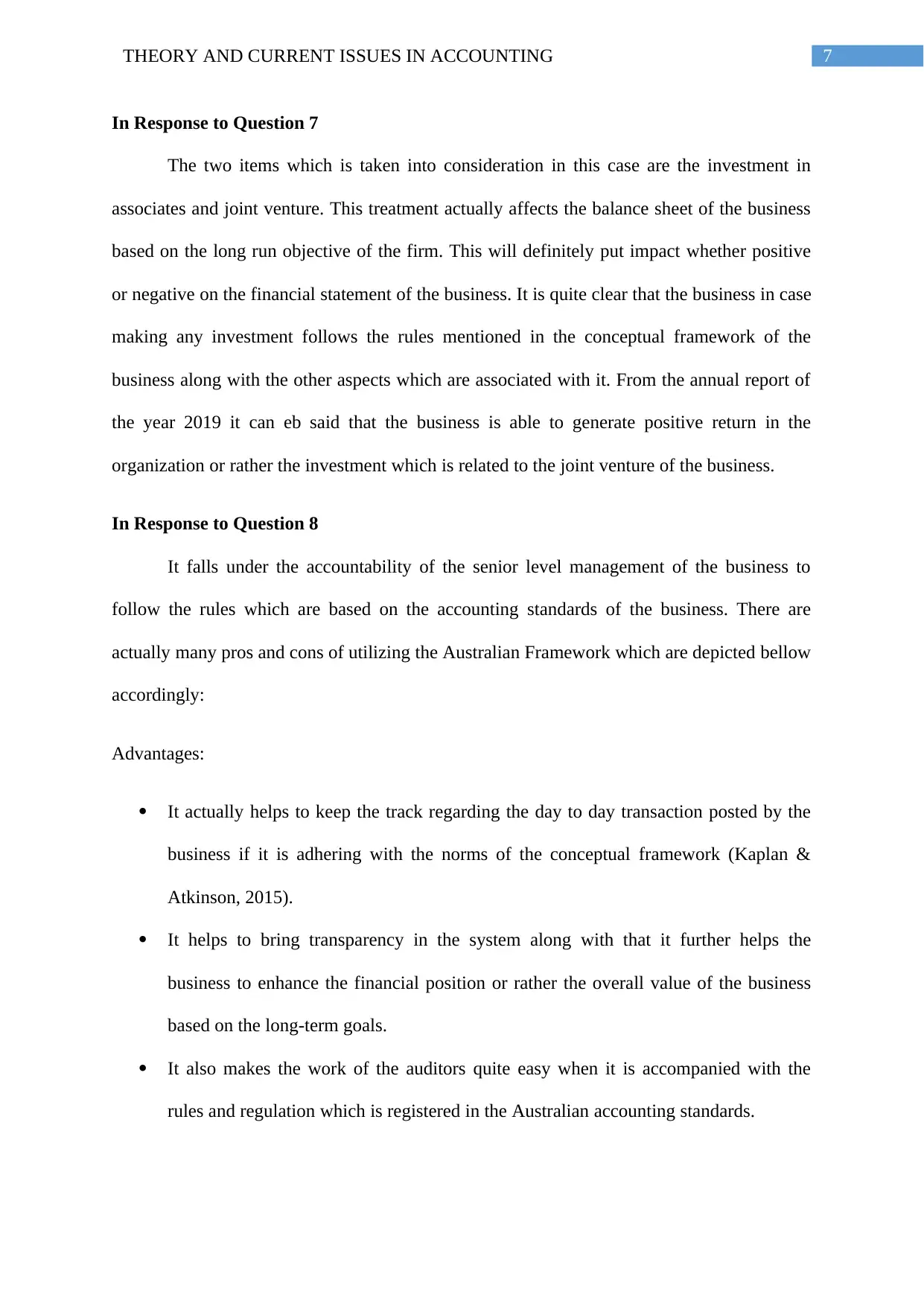
7THEORY AND CURRENT ISSUES IN ACCOUNTING
In Response to Question 7
The two items which is taken into consideration in this case are the investment in
associates and joint venture. This treatment actually affects the balance sheet of the business
based on the long run objective of the firm. This will definitely put impact whether positive
or negative on the financial statement of the business. It is quite clear that the business in case
making any investment follows the rules mentioned in the conceptual framework of the
business along with the other aspects which are associated with it. From the annual report of
the year 2019 it can eb said that the business is able to generate positive return in the
organization or rather the investment which is related to the joint venture of the business.
In Response to Question 8
It falls under the accountability of the senior level management of the business to
follow the rules which are based on the accounting standards of the business. There are
actually many pros and cons of utilizing the Australian Framework which are depicted bellow
accordingly:
Advantages:
It actually helps to keep the track regarding the day to day transaction posted by the
business if it is adhering with the norms of the conceptual framework (Kaplan &
Atkinson, 2015).
It helps to bring transparency in the system along with that it further helps the
business to enhance the financial position or rather the overall value of the business
based on the long-term goals.
It also makes the work of the auditors quite easy when it is accompanied with the
rules and regulation which is registered in the Australian accounting standards.
In Response to Question 7
The two items which is taken into consideration in this case are the investment in
associates and joint venture. This treatment actually affects the balance sheet of the business
based on the long run objective of the firm. This will definitely put impact whether positive
or negative on the financial statement of the business. It is quite clear that the business in case
making any investment follows the rules mentioned in the conceptual framework of the
business along with the other aspects which are associated with it. From the annual report of
the year 2019 it can eb said that the business is able to generate positive return in the
organization or rather the investment which is related to the joint venture of the business.
In Response to Question 8
It falls under the accountability of the senior level management of the business to
follow the rules which are based on the accounting standards of the business. There are
actually many pros and cons of utilizing the Australian Framework which are depicted bellow
accordingly:
Advantages:
It actually helps to keep the track regarding the day to day transaction posted by the
business if it is adhering with the norms of the conceptual framework (Kaplan &
Atkinson, 2015).
It helps to bring transparency in the system along with that it further helps the
business to enhance the financial position or rather the overall value of the business
based on the long-term goals.
It also makes the work of the auditors quite easy when it is accompanied with the
rules and regulation which is registered in the Australian accounting standards.
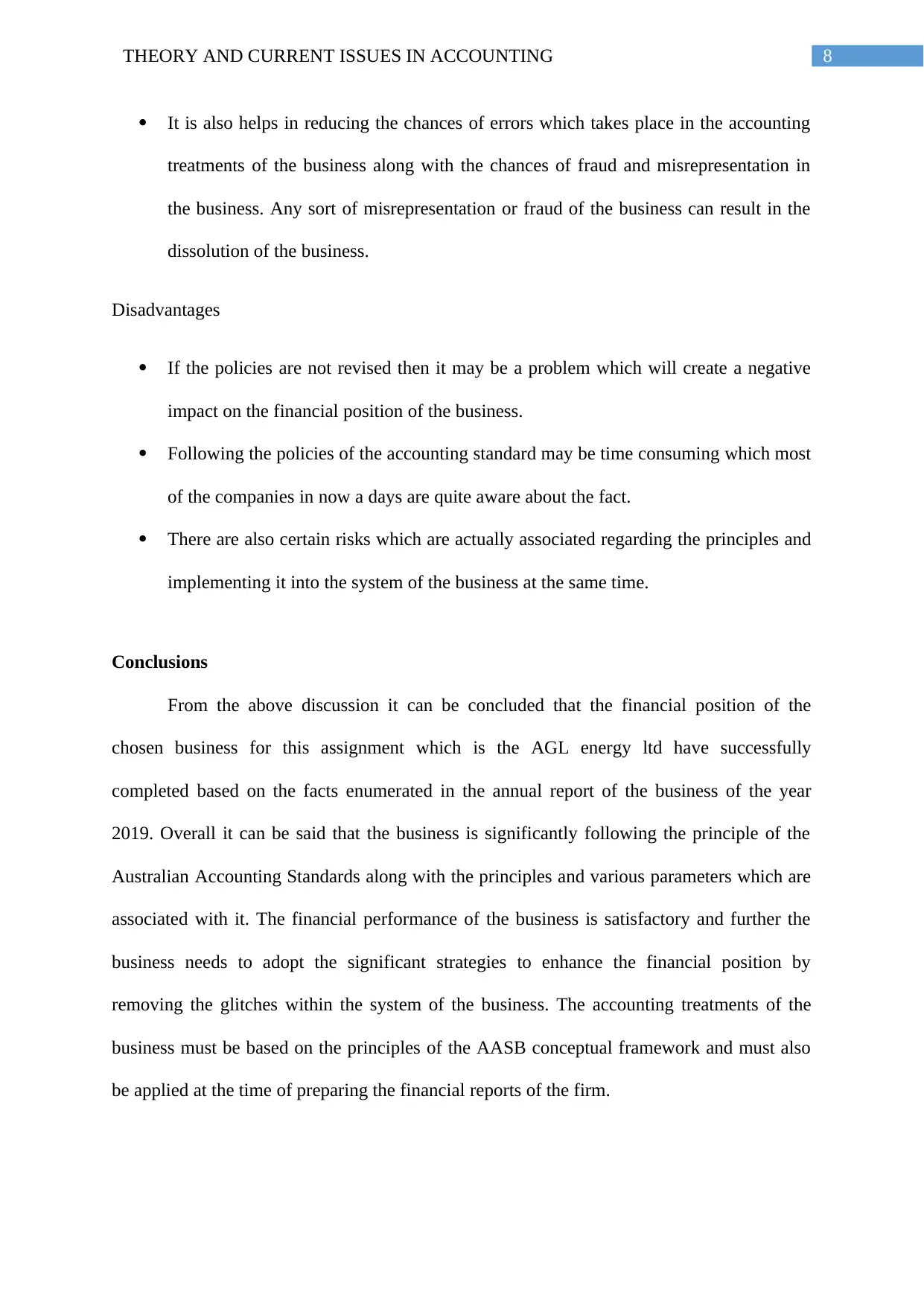
8THEORY AND CURRENT ISSUES IN ACCOUNTING
It is also helps in reducing the chances of errors which takes place in the accounting
treatments of the business along with the chances of fraud and misrepresentation in
the business. Any sort of misrepresentation or fraud of the business can result in the
dissolution of the business.
Disadvantages
If the policies are not revised then it may be a problem which will create a negative
impact on the financial position of the business.
Following the policies of the accounting standard may be time consuming which most
of the companies in now a days are quite aware about the fact.
There are also certain risks which are actually associated regarding the principles and
implementing it into the system of the business at the same time.
Conclusions
From the above discussion it can be concluded that the financial position of the
chosen business for this assignment which is the AGL energy ltd have successfully
completed based on the facts enumerated in the annual report of the business of the year
2019. Overall it can be said that the business is significantly following the principle of the
Australian Accounting Standards along with the principles and various parameters which are
associated with it. The financial performance of the business is satisfactory and further the
business needs to adopt the significant strategies to enhance the financial position by
removing the glitches within the system of the business. The accounting treatments of the
business must be based on the principles of the AASB conceptual framework and must also
be applied at the time of preparing the financial reports of the firm.
It is also helps in reducing the chances of errors which takes place in the accounting
treatments of the business along with the chances of fraud and misrepresentation in
the business. Any sort of misrepresentation or fraud of the business can result in the
dissolution of the business.
Disadvantages
If the policies are not revised then it may be a problem which will create a negative
impact on the financial position of the business.
Following the policies of the accounting standard may be time consuming which most
of the companies in now a days are quite aware about the fact.
There are also certain risks which are actually associated regarding the principles and
implementing it into the system of the business at the same time.
Conclusions
From the above discussion it can be concluded that the financial position of the
chosen business for this assignment which is the AGL energy ltd have successfully
completed based on the facts enumerated in the annual report of the business of the year
2019. Overall it can be said that the business is significantly following the principle of the
Australian Accounting Standards along with the principles and various parameters which are
associated with it. The financial performance of the business is satisfactory and further the
business needs to adopt the significant strategies to enhance the financial position by
removing the glitches within the system of the business. The accounting treatments of the
business must be based on the principles of the AASB conceptual framework and must also
be applied at the time of preparing the financial reports of the firm.
⊘ This is a preview!⊘
Do you want full access?
Subscribe today to unlock all pages.

Trusted by 1+ million students worldwide
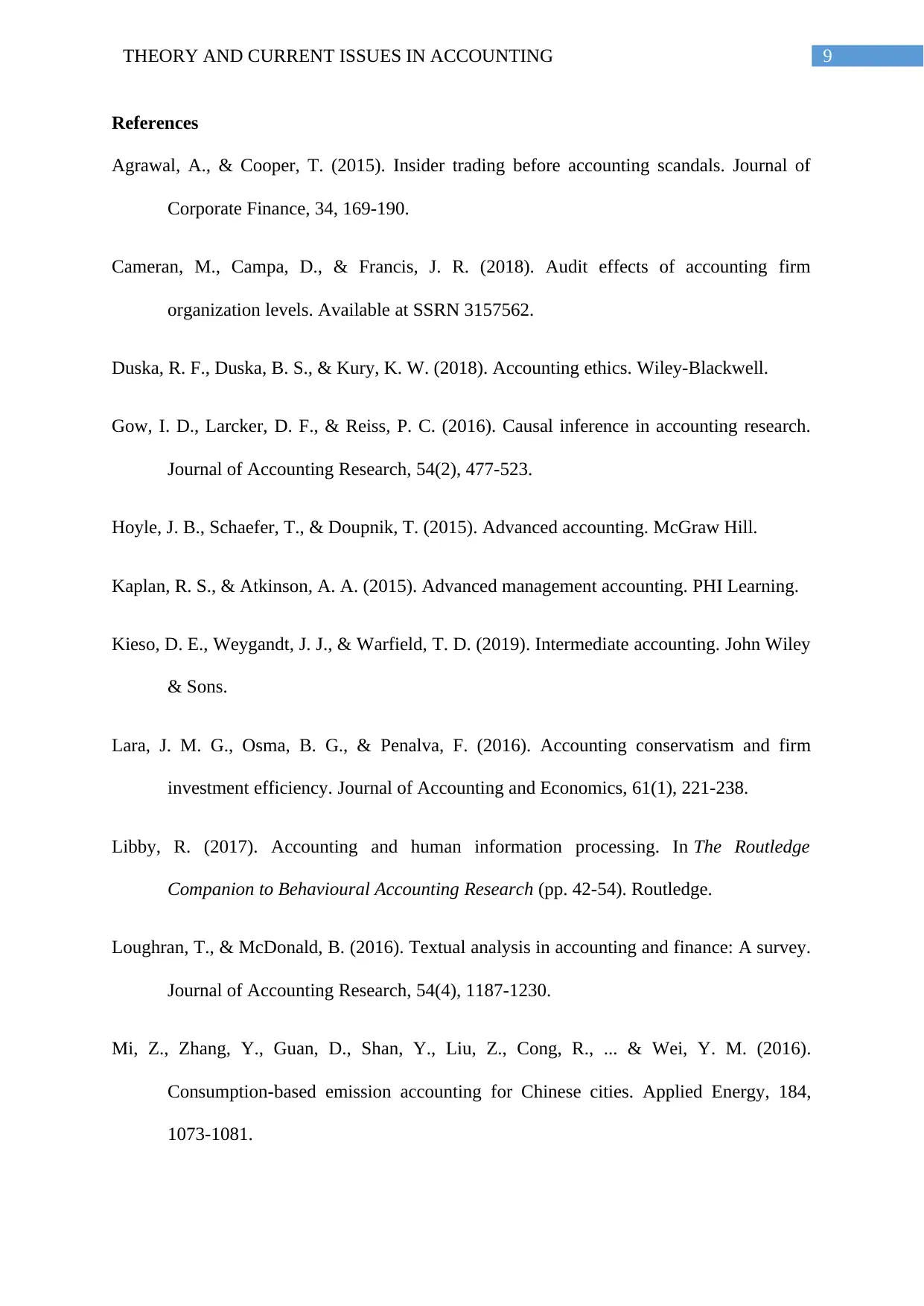
9THEORY AND CURRENT ISSUES IN ACCOUNTING
References
Agrawal, A., & Cooper, T. (2015). Insider trading before accounting scandals. Journal of
Corporate Finance, 34, 169-190.
Cameran, M., Campa, D., & Francis, J. R. (2018). Audit effects of accounting firm
organization levels. Available at SSRN 3157562.
Duska, R. F., Duska, B. S., & Kury, K. W. (2018). Accounting ethics. Wiley-Blackwell.
Gow, I. D., Larcker, D. F., & Reiss, P. C. (2016). Causal inference in accounting research.
Journal of Accounting Research, 54(2), 477-523.
Hoyle, J. B., Schaefer, T., & Doupnik, T. (2015). Advanced accounting. McGraw Hill.
Kaplan, R. S., & Atkinson, A. A. (2015). Advanced management accounting. PHI Learning.
Kieso, D. E., Weygandt, J. J., & Warfield, T. D. (2019). Intermediate accounting. John Wiley
& Sons.
Lara, J. M. G., Osma, B. G., & Penalva, F. (2016). Accounting conservatism and firm
investment efficiency. Journal of Accounting and Economics, 61(1), 221-238.
Libby, R. (2017). Accounting and human information processing. In The Routledge
Companion to Behavioural Accounting Research (pp. 42-54). Routledge.
Loughran, T., & McDonald, B. (2016). Textual analysis in accounting and finance: A survey.
Journal of Accounting Research, 54(4), 1187-1230.
Mi, Z., Zhang, Y., Guan, D., Shan, Y., Liu, Z., Cong, R., ... & Wei, Y. M. (2016).
Consumption-based emission accounting for Chinese cities. Applied Energy, 184,
1073-1081.
References
Agrawal, A., & Cooper, T. (2015). Insider trading before accounting scandals. Journal of
Corporate Finance, 34, 169-190.
Cameran, M., Campa, D., & Francis, J. R. (2018). Audit effects of accounting firm
organization levels. Available at SSRN 3157562.
Duska, R. F., Duska, B. S., & Kury, K. W. (2018). Accounting ethics. Wiley-Blackwell.
Gow, I. D., Larcker, D. F., & Reiss, P. C. (2016). Causal inference in accounting research.
Journal of Accounting Research, 54(2), 477-523.
Hoyle, J. B., Schaefer, T., & Doupnik, T. (2015). Advanced accounting. McGraw Hill.
Kaplan, R. S., & Atkinson, A. A. (2015). Advanced management accounting. PHI Learning.
Kieso, D. E., Weygandt, J. J., & Warfield, T. D. (2019). Intermediate accounting. John Wiley
& Sons.
Lara, J. M. G., Osma, B. G., & Penalva, F. (2016). Accounting conservatism and firm
investment efficiency. Journal of Accounting and Economics, 61(1), 221-238.
Libby, R. (2017). Accounting and human information processing. In The Routledge
Companion to Behavioural Accounting Research (pp. 42-54). Routledge.
Loughran, T., & McDonald, B. (2016). Textual analysis in accounting and finance: A survey.
Journal of Accounting Research, 54(4), 1187-1230.
Mi, Z., Zhang, Y., Guan, D., Shan, Y., Liu, Z., Cong, R., ... & Wei, Y. M. (2016).
Consumption-based emission accounting for Chinese cities. Applied Energy, 184,
1073-1081.
Paraphrase This Document
Need a fresh take? Get an instant paraphrase of this document with our AI Paraphraser
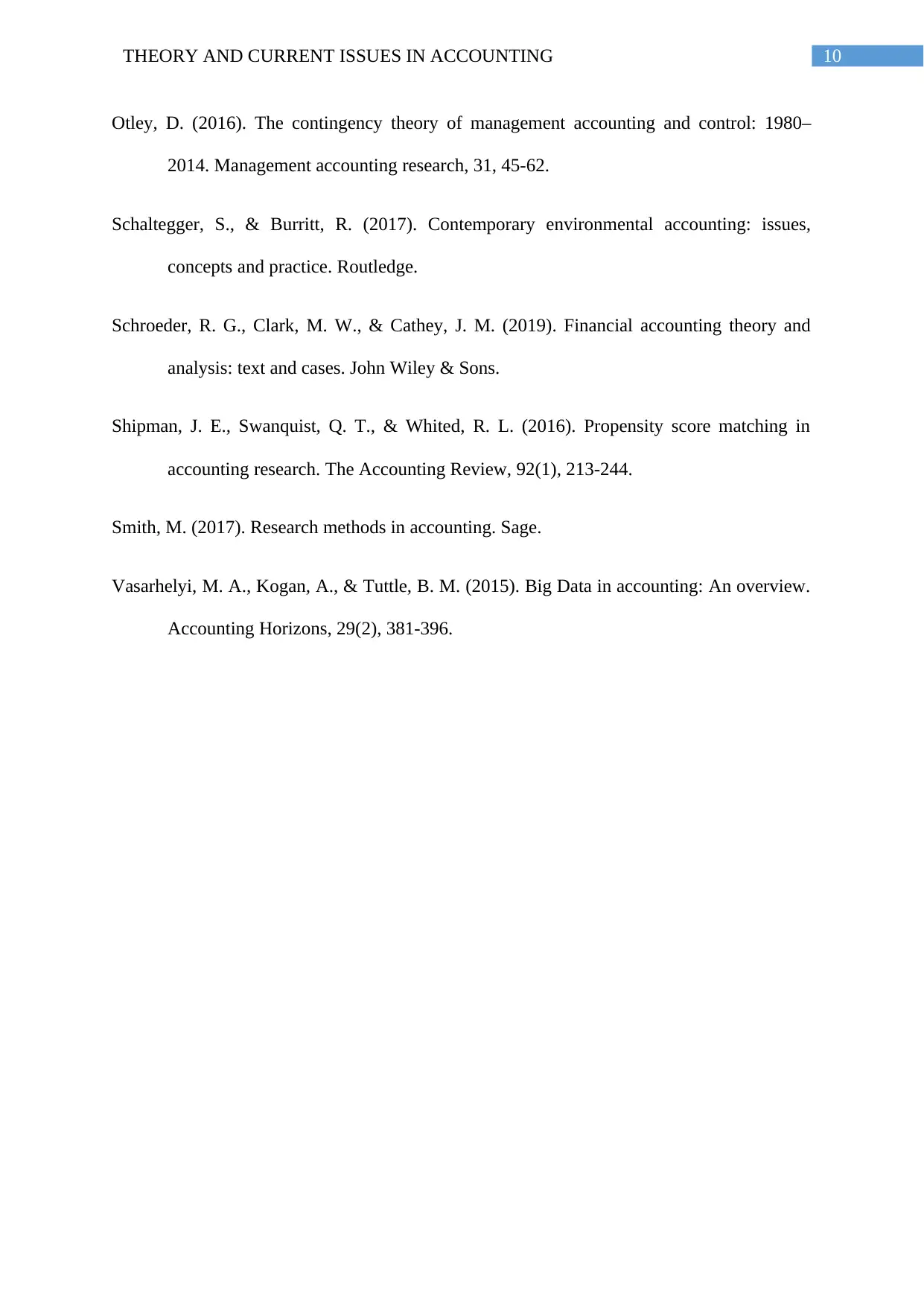
10THEORY AND CURRENT ISSUES IN ACCOUNTING
Otley, D. (2016). The contingency theory of management accounting and control: 1980–
2014. Management accounting research, 31, 45-62.
Schaltegger, S., & Burritt, R. (2017). Contemporary environmental accounting: issues,
concepts and practice. Routledge.
Schroeder, R. G., Clark, M. W., & Cathey, J. M. (2019). Financial accounting theory and
analysis: text and cases. John Wiley & Sons.
Shipman, J. E., Swanquist, Q. T., & Whited, R. L. (2016). Propensity score matching in
accounting research. The Accounting Review, 92(1), 213-244.
Smith, M. (2017). Research methods in accounting. Sage.
Vasarhelyi, M. A., Kogan, A., & Tuttle, B. M. (2015). Big Data in accounting: An overview.
Accounting Horizons, 29(2), 381-396.
Otley, D. (2016). The contingency theory of management accounting and control: 1980–
2014. Management accounting research, 31, 45-62.
Schaltegger, S., & Burritt, R. (2017). Contemporary environmental accounting: issues,
concepts and practice. Routledge.
Schroeder, R. G., Clark, M. W., & Cathey, J. M. (2019). Financial accounting theory and
analysis: text and cases. John Wiley & Sons.
Shipman, J. E., Swanquist, Q. T., & Whited, R. L. (2016). Propensity score matching in
accounting research. The Accounting Review, 92(1), 213-244.
Smith, M. (2017). Research methods in accounting. Sage.
Vasarhelyi, M. A., Kogan, A., & Tuttle, B. M. (2015). Big Data in accounting: An overview.
Accounting Horizons, 29(2), 381-396.
1 out of 11
Related Documents
Your All-in-One AI-Powered Toolkit for Academic Success.
+13062052269
info@desklib.com
Available 24*7 on WhatsApp / Email
![[object Object]](/_next/static/media/star-bottom.7253800d.svg)
Unlock your academic potential
Copyright © 2020–2025 A2Z Services. All Rights Reserved. Developed and managed by ZUCOL.



